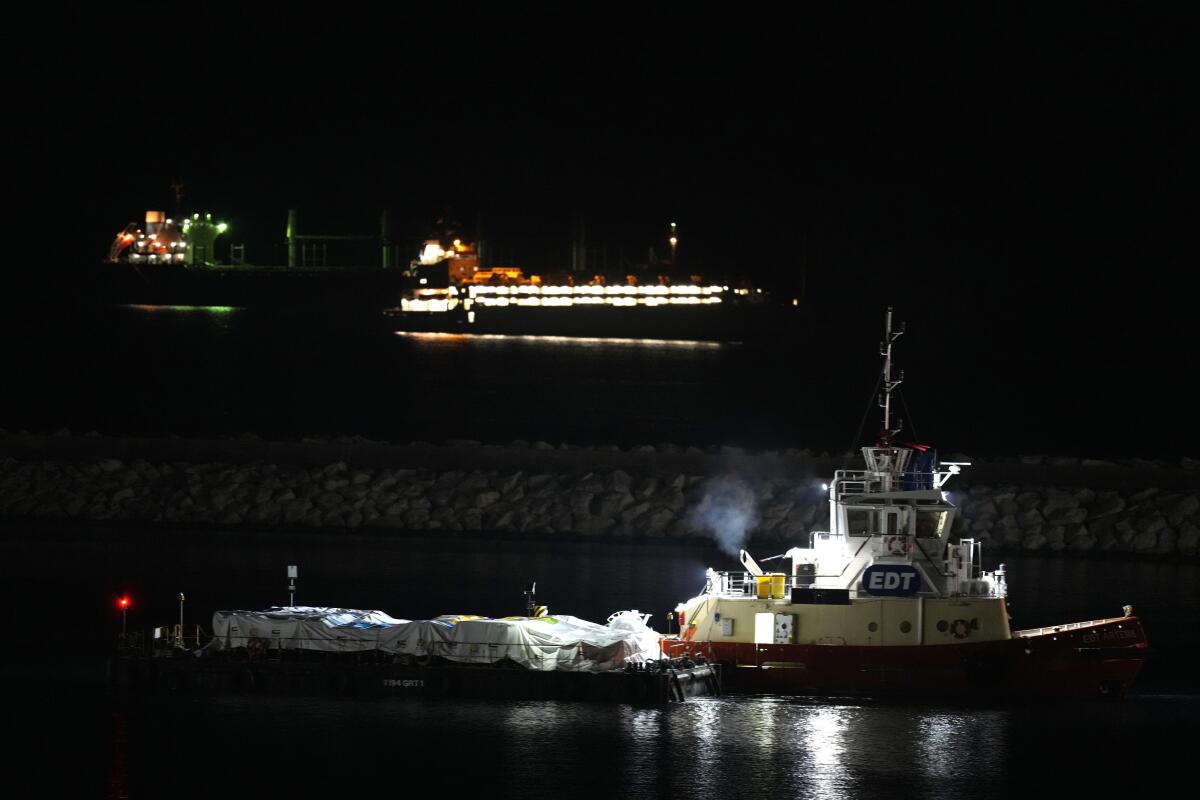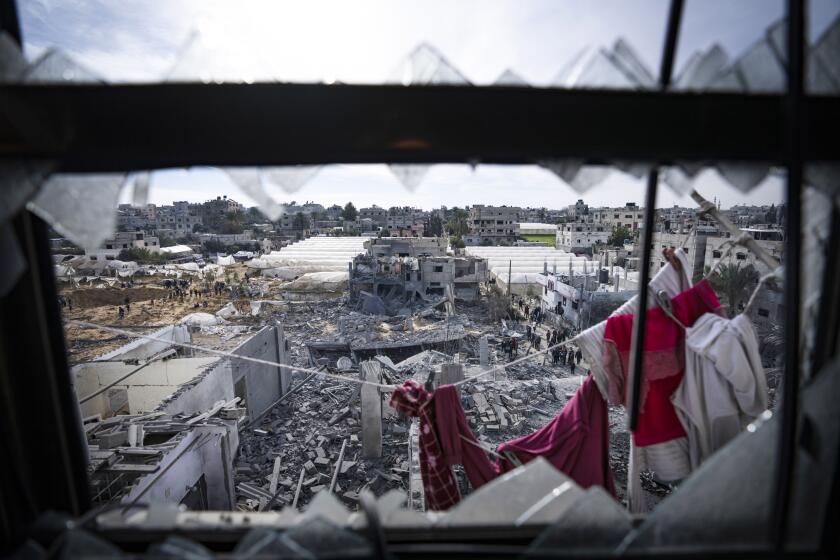A floating pier in Gaza: Why the U.S. sees it as a solution to aid deliveries

- Share via
BEIRUT — As Gaza’s 2.3 million residents face what United Nations officials describe as “catastrophic” levels of hunger, the United States, the European Union and other countries are beginning construction of a temporary pier to deliver aid by sea.
The first steps came over the weekend, when the U.S. Army announced that a ship was on its way to the Mediterranean Sea carrying the equipment to build the port — a project that could take two months.
Here’s a look at the project and its complications.
How does aid currently reach Gaza?
Since Hamas attacked southern Israel on Oct. 7, Israel has dramatically reduced deliveries of food and water and completely cut off gas to Gaza. The enclave had already been subject to blockade by Israel and Egypt since 2007.
Aid still enters Gaza from Israel through the Kerem Shalom border crossing as well as from Egypt through the Rafah crossing. But Israel refuses to open two additional crossings, and where it does allow passage, aid groups say its inspectors routinely deny the entry of legitimate humanitarian goods.
With family trapped in Gaza, two Palestinian friends in the West Bank hold each other up amid crushing grief.
Once goods enter the enclave, distribution is a challenge. Israeli forces have been accused of attacking U.N. aid convoys as well as security personnel who are supposed to protect them.
In February, Israeli troops fired into a crowd that had surrounded an aid convoy at a checkpoint, killing 118 Palestinians, authorities in Gaza said. The Israeli military released a report this month saying that “troops did not fire at the humanitarian convoy, but did fire at a number of suspects who approached the nearby forces and posed a threat to them.”
Israel insists it does not impede aid. It blames the U.N. for the lack of distribution while accusing Hamas of diverting and selling assistance coming in for its own purposes.
The United States, France and others have airdropped tens of thousands of military-style meals into Gaza, but those deliveries have fallen far short of the 6.6 million meals that are needed each day.
Aid groups point out that one truck can carry the same cargo as multiple C-130 transport planes. Packages have also landed in the sea or in Israel. And this past weekend, five Gazans were struck and killed by a package with a parachute that failed to open.
What is the current state of the food supply in Gaza?
The U.N. warned last month that a quarter of Gaza’s population is one step away from famine. Palestinian authorities said Sunday that the death toll from malnutrition had reached 25.
With most of Gaza’s population displaced and living in Rafah, the situation is most dire for the 300,000 still in the north, who remain almost completely cut off from aid.
As the holy month of Ramadan was set to begin on Monday, Ahmad Al-Banna, 29, had come to Gaza City to buy food that he intended to donate to people in the north.
Experts say Israel’s deadly raid on a West Bank hospital may have violated international laws, including a ban on combatants posing as doctors or civilians.
“But there’s nothing to buy,” he said. “All you can find in stores is ketchup bottles and pickle jars.”
He said people were living on khobiza — a type of mallow that grew in open fields — and any potatoes left they could dig up.
Israeli officials deny there is a food shortage and say that the use of the word “hunger” to describe circumstances is “exaggerated,” according to a report from the Jerusalem Post.
Doesn’t Gaza already have a port?
The main fishing harbor in Gaza City is too damaged to be able to receive ships, and in any case too shallow for many types of vessels. Other piers are also unsuitable for shipping.
British Foreign Secretary David Cameron has proposed that ships offload their cargo at the Israeli port of Ashdod to be driven into Gaza, but Israel has rejected that idea.
So what’s the plan?
U.S. officials say the solution is to build a port. A U.S. Army logistics support boat, the Gen. Frank S. Besson, was on its way over the weekend to begin construction.
More than 1,000 U.S. military personnel will work to build an offshore floating pier and a two-lane causeway, said Air Force Maj. Gen. Pat Ryder, the Pentagon press secretary.
Gazans crammed into Rafah along the Egyptian border have no place to escape as Israeli attacks hit ever closer in a final bid to rescue remaining hostages.
Large ships will dock at the pier and offload their cargo to smaller vessels, which would ferry shipments to the causeway and from there into Gaza. It’s unclear how the aid will be distributed once inside the enclave.
Ryder said that the operation would eventually deliver “upwards of 2 million meals a day” but that construction could take up to two months.
Two months is a long time. What about now?
The more immediate option is the one proposed by the European Union, which calls for aid to be collected in the Cypress port of Larnaca and inspected by a committee of nations that includes Israel. Warships would escort the vessels to shore, though it is unclear where they would dock and unload.
Hoping to go first are the operators of the Spanish-flagged rescue vessel Open Arms, which is currently docked in Larnaca. It is loaded with 200 tons of food from the U.S. charity World Central Kitchen, which operates 60 kitchens inside Gaza that have served about 32 million meals since the war began.
While Gazans hold Israel principally responsible for their suffering, many also blame Hamas for not foreseeing the consequences of its Oct. 7 attack.
In good weather, the Open Arms could make the 230-mile voyage in about 16 hours. But the real challenge is the last mile. To prevent Gazans from getting on board — a prospect that aid workers fear would invite Israeli military action — the group has suggested that the the ship could tow a barge loaded with food pallets and then push it to shore.
World Central Kitchen has also contracted a team inside Gaza to build a 120-foot pier at an undisclosed location on the coast.
What do aid groups think of the U.S. plan to build a pier?
Despite Western governments expressing enthusiasm, aid groups have been critical.
“The U.S. plan for a temporary pier in Gaza to increase the flow of humanitarian aid is a glaring distraction from the real problem: Israel’s indiscriminate and disproportionate military campaign and punishing siege,” Avril Benoit, executive director for Doctors Without Borders U.S.A, said in a statement.
“This is not a logistics problem; it is a political problem,” she said. “Rather than look to the U.S. military to build a workaround, the U.S. should insist on immediate humanitarian access using the roads and entry points that already exist.”
More to Read
Sign up for Essential California
The most important California stories and recommendations in your inbox every morning.
You may occasionally receive promotional content from the Los Angeles Times.


















